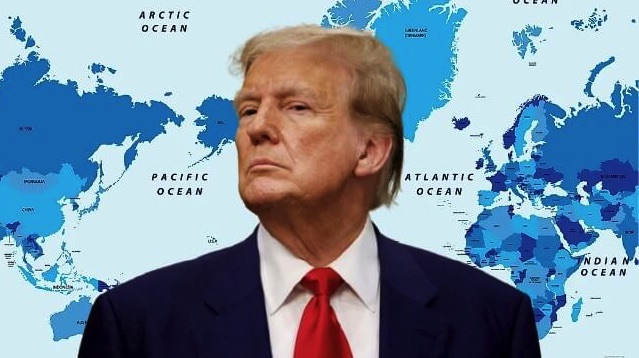By George McMillan III
Five-part structured essay:
1. The Need for a Baseline Sea Power versus Land Power Geostrategic Model
Key points:
Geostrategic Framework – The development of a Sea Power versus Land Power model aims to provide a comprehensive understanding of global strategies in geoeconomics and geopolitics, facilitating the analysis of interactions between these two forces. This model draws on methodologies from game theory to analyze social dynamics and predict strategic moves in a transitioning multipolar world.
Historical Context and Theoretical Foundations – The model is rooted in theories of rational behavior, contrasting with functionalist approaches, and leverages insights from notable theorists like John von Neumann and John Harsanyi. It revisits the Cold War dynamics of industrial power centers to better understand current geopolitical tensions, specifically between Atlanticist and Eurasianist perspectives.
Strategic Objectives and Influences – The Western elite’s Sea Power strategy aims to economically isolate Russia, influenced by the works of strategic thinkers like Zbigniew Brzezinski and Paul Wolfowitz. Key documents, including RAND reports, outline the rationale and methods for extending American influence post-Soviet Union, emphasizing the importance of understanding these strategies for effective analysis of global power dynamics.
The Hierarchical Framework of Warfare identifies– It includes four levels: Global Grand Strategic, Regional Strategic, Operational, and Tactical, across nine unrestricted warfare domains, including financial, political, and media institutions, illustrating how elites orchestrate actions and narratives to maintain control over geopolitical dynamics.
The Coordinated Efforts of Western Elites – To shape information and political discourse, leveraging a Sea Power versus Land Power strategy to resist shifts in global power dynamics, exemplified by the resistance to Russia’s energy influence, which poses a challenge to their established interests.
2. The Railroad and the Evolution of Sea Power versus Land Power Strategies
Key points:
Mackinder’s Geopolitical Theories – In his works, Mackinder argued for the significance of overland logistical supply routes connecting resources from the Russian Heartland to Europe, emphasizing the strategic importance of controlling Poland and Eastern Europe to prevent economic integration between Germany and Russia.
Eurasianist vs. Atlanticist Strategies – The ongoing geopolitical conflicts, including the Russo-Ukrainian war and tensions in Iran, reflect the rivalry between Atlanticist Sea Power, which seeks control over maritime routes, and Eurasian Land Power, focused on securing land-based resources and supply routes, often utilizing proxy wars to achieve their objectives.
Proxy Warfare and Strategic Hierarchies – The extension of superpower influence through proxy wars exploits ethnic and religious divisions, with a focus on controlling key logistical choke points to access and profit from natural resources, revealing the dual nature of military actions that often mask underlying economic motivations.
Geopolitical and Economic Modeling – The research discusses integrated causal models that assess geopolitical outcomes based on evolutionary, psychological, and economic frameworks. These models are crucial for understanding global strategic dynamics, particularly the interplay between Sea Power and Land Power strategies, which have historical roots in colonial mercantile conflicts.
Impact on Modern Conflicts and Policy – The ongoing Russo-Ukraine War and U.S. foreign policy illustrate the relevance of historical Sea Power versus Land Power strategies. The neoconservative approach to foreign intervention lacks a nuanced understanding of these strategies, leading to miscalculations in anticipating adversarial responses and the underlying motives behind geopolitical actions.
3. The Hapless Keith Kellogg and the Appeasement of the Postmodern European Politicians
Key points:
Decision-Making and Public Justification– The Western financial and governmental decision-makers conduct geoeconomic and geopolitical analysis formulated to their objectives, creating publicly palatable narratives or “ostensible causes” to justify their actions, which often mask their true, proprietary strategic plans.
Impact of Education on Society and Governance – The abandonment of scientific inquiry in Western universities since the 1980s has resulted in a political landscape dominated by leaders unversed in essential stability parameters, ultimately contributing to societal delusion and the decline of effective governance, reminiscent of the failures seen in historical communist experiments. A network of research foundations, NGOs, and media in the West prioritize persuasive communication over critical analytical skills, leading to a generation of graduates who may lack the ability to critically assess underlying motives.
Impact of Postmodernism on Energy Policies – The rise of postmodernist ideologies in political power has led to significant energy policy decisions in Europe, such as the closure of coal and nuclear plants in Germany and the Groningen gas field in the Netherlands, while promoting strategies to economically isolate Russia, ultimately resulting in destabilization of the European economies.
Potential Populist Resurgence – There is a growing fear among Western elites that populist leaders in countries like Germany and Austria could disrupt the current geopolitical landscape by reviving economic ties with Russia, particularly through natural gas procurement, which could lead to a shift away from the EU and NATO alliances.
Geopolitical Ramifications of Russian Influence – The potential alliance of the German-speaking and Danube River Slavic nations, driven by populist movements, poses a significant threat to Western interests, as it could lead to a unified economic and political front that shifts power dynamics in favor of Russia and undermines Western sanctions and influence.
4. The First Sixteen Concerns of the Western Financiers, the Super Power-Major Power-Vassal State Hierarchies and DIME Integration
Key points:
Geoeconomic and Geostrategic Integration – Geoeconomic strategies focus on the integration of trading blocs and military alliances to facilitate peaceful trade of resources, while geostrategic plans aim to expand influence through maritime and terrestrial chokepoints, affecting the dynamics between superpowers and their vassals.
Impact of the Global War on Terror – The US and UK’s involvement in the Middle East and Eastern Europe has been aimed at countering Russian energy pipeline expansions, using propaganda and media control to shape public perception, and creating political instability in regions critical to Russia’s trade routes.
The Silk Road Initiative – Nixon and Kissinger’s strategy to integrate China has led to significant job offshoring from the US, while with the Silk Road Initiative China has establish logistical routes to resource-rich areas, enhancing cooperation with Russia in energy supply chains, particularly in the Far East, countering maritime choke points through overland routes, reinforcing maritime control and engaging in covert operations in the Eurasian Rimland.
The U.S./UK/NATO Alliance – It aims to economically isolate Russia by controlling critical logistics routes and preventing the flow of profits to Eurasian financial centers, thereby destabilizing the region and transforming targeted nations into vassal states that supply commodities to Western powers.
Geopolitical Tensions and NATO’s Role – As NATO and the EU expanded eastward, Russia perceived this as an attempt to establish dominance over commodity-rich regions, leading to increased military presence and training in Eastern Europe, which further exacerbated tensions between Russia and the West.
Manipulation of Narratives – The West’s portrayal of events, such as the Ukraine crisis, is seen as a strategic psyop involving media manipulation and false narratives to undermine populist leaders like Putin and to maintain control over political outcomes in various regions, reflecting a broader pattern of elite-driven interventions.
5. The Russian Natural Gas Pipeline Network, and Eurasian DIME Integration
Key points:
Significance of Russian gas – The Russian Natural Gas Eurasian pipeline network and the joint Russo-Sino-Eurasian railway network create overland logistical routes that economically and militarily integrate Eurasia, bypassing Western maritime choke points and directing profits to Moscow and Beijing instead of Western financial capitals.
The Fears of the West – Western elites fear the growing influence of Russian natural gas pipelines, as they provide cheap and clean energy, potentially lowering manufacturing costs in connected countries, elevating living standards, and shifting global economic power from the West to Eurasia.
The Western Reaction – The response of the Western countries has included military and economic strategies aimed at encircling Russia and preventing the formation of a cohesive Eurasian Economic Union, which could undermine Western dominance and accelerate the rise of alternative economic blocs.
Geopolitical Realignment – The alliance between Russia, China, and Iran has strengthened in response to Western strategies aimed at encircling and economically strangling these nations, particularly following events such as the 2014 Euromaidan coup in Ukraine.
Defensive Strategies – In light of Western sanctions and geopolitical pressures, Russia has shifted its resources away from costly pipeline projects to enhancing its logistical supply routes and coordinating a defensive perimeter against Western influence, particularly in Europe.
Listen to the full essay:
Read the full essay (Pdf): Trump’s Foreign Policy Issues in the Light of the Geostrategic Sea/Land Model

Author: George McMillan III – George has been a private military contractor in Iraq and Afghanistan since early 2010. He has worked as a Vehicle Explosive Detection Checkpoint Supervisor, Future Operations Planning, Atmospheric Counterinsurgency Intelligence, and an Operations Security Specialist and Terrorism Threat Assessment Analyst.







